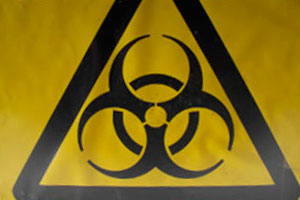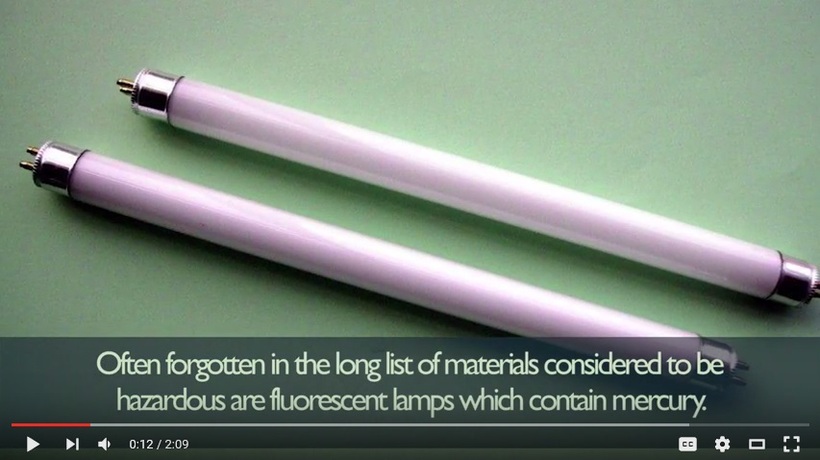
Hazardous Waste Warning
LessIsMore.org works best in modern browsers like Firefox, Safari, Chrome, or Internet Explorer 8. All are free to download and will greatly improve your internet experience. Wastes in this section are dangerous to you and the environment. Handle them carefully and dispose of them properly. Legally, households may not transport more than 15 gallons of wet or 125 pounds of dry hazardous materials. Read about the regulation.
Watch our new Fluorescent Lights Video!
Click here or below:
Broken Fluorescent Lights
If you accidentally break a light, follow the steps below to make sure that the bulbs are cleaned up safely. Keep in mind that in California fluorescent bulbs and tubes are prohibited from trash disposal. You'll need to take the broken bulbs to one of the collection centers listed on our Fluorescent Tube or Compact Fluorescent Light (CFL) pages.
Before Clean-Up: Air Out the Room
- Evacuate all people and pets and make sure no one walks through the breakage area on the way out
- Open all windows and leave the room for at least 15 minutes
- Shut off the central forced-air heating and air conditioning systems
Hard Surface Clean-Up
- Wearing gloves, carefully scoop up glass pieces and powder using stiff paper or cardboard and place them in a glass jar with a metal lid (such as a canning jar) or in a sealed plastic bag
- Use sticky tape, such as duct tape, to pick up any remaining small glass fragments and powder
- Wipe the area clean with damp paper towels or disposable wet wipes, and place the towels in the glass jar or plastic bag
- Do not use a vacuum or broom to clean up the broken bulb on hard surfaces
Carpet or Rug Clean-Up
- Wearing gloves, carefully scoop up glass pieces and powder using stiff paper or cardboard and place them in a glass jar with a metal lid (such as a canning jar) or in a sealed plastic bag
- Use sticky tape, such as duct tape, to pick up any remaining small glass fragments and powder
- If vacuuming is needed after all visible materials are removed, vacuum the area where the bulb was broken
- Remove the vacuum bag (or empty and wipe the canister) and put the bag and vacuum debris in a sealed plastic bag
Clothing, Bedding or other Soft Material Clean Up
- If clothing or bedding materials come in direct contact with the broken glass or mercury-containing powder from the inside of the bulb, the clothing or bedding should be thrown away because the mercury and glass may stick to the fabric. Do not wash such clothing or bedding because mercury fragments in the clothing may contaminate the machine and/or pollute sewage.
- You can, however, wash clothing or other materials that have been exposed to the mercury vapor from a broken Compact Fluorescent Light (CFL), such as the clothing you are wearing when you cleaned up the broken CFL. As long as that clothing has not come in into direct contact with the materials from the broken bulb, you should be fine.
- If shoes come into direct contact with powder from the bulb, wipe them off with a damp paper towel or disposable wet wipes. Place the towels or wipes in a glass jar or plastic bag for disposal.
Disposing of Clean-Up Materials
- Immediately place all clean-up materials outdoors in a protected area until you're ready to bring them to a collection center
- When ready, take these materials to one of the hazardous waste facilities listed on our Fluorescent Tube or Compact Fluorescent Light (CFL) pages
Future Cleaning of a Carpet or Rug
- The next several times you vacuum, turn off any central forced-air heating and air conditioning systems and open a window before vacuuming
- Keep the central heating and air conditioning system turned off and the window open for at least 15 minutes after you are done vacuuming
More Information
People use other products that contain mercury, not just fluorescent lights. In the event that any of these products break, certain steps need to be taken for safe clean-up and disposal. Check out the US Environmental Protection Agency's website for more information on storing, transporting, and disposing of mercury.
Related Materials
- Fluorescent Light Tubes
- CFLs – Compact Fluorescent Lights
- Hazardous Waste Regulation
- Hazardous Waste Haulers
Related Articles
-
April 7th Hazardous Waste Collection Event
March 03, 2019 by Leslie Robinson - Hazardous Waste Recycling/Disposal -
Holiday Facility Closures
December 20, 2023 by Tori Kampmann - Hazardous Waste Recycling/Disposal -
“Less Is More” Guide Hot Off the Press
January 18, 2023 by Kaitlyn Haberlin - Recycle, Reduce & Reuse -
America Recycles Day November 15th
November 08, 2019 by Leslie Robinson - Recycle -
Latest Annual Report Available for County’s Hazardous Waste Collection Program
January 10, 2024 by Tori Kampmann - Hazardous Waste Recycling/Disposal -
Thomas Fire Clean-Up Tips & Guidelines
-
Thanksgiving Facility Closures
November 22, 2023 by Tori Kampmann - Hazardous Waste Recycling/Disposal -
RRWM’s Annual Waste Management Report Now Available
October 05, 2017 by Alan Nakashima - Recycle -
Easy Battery Recycling at Curbside
May 31, 2019 by Jody Rundle - Hazardous Waste Recycling/Disposal -
Safely Disposing of Fluorescent Lights
May 24, 2016 by Jody Rundle - Hazardous Waste Recycling/Disposal -
Free Hazardous Waste Events October 5 & 6
September 30, 2019 by Leslie Robinson -
Reminder: Santa Ynez Valley Hazardous Waste Collection Event Postponed
March 23, 2020 by Leslie Robinson -
Hazardous Waste Collection Center Temporarily Closed – Updated 3/30/20
March 30, 2020 by Leslie Robinson - Hazardous Waste Recycling/Disposal -
Hazardous Waste Disposal Options in Santa Barbara County
June 04, 2021 by Tori Kampmann - Hazardous Waste Recycling/Disposal -
FREE Household Hazardous Waste Event!
March 31, 2024 by Kaitlyn Haberlin - Hazardous Waste Recycling/Disposal -
New Year, New Protocol!
February 02, 2022 by Tori Kampmann -
2022/2023 Resource Recovery Waste Management Annual Report
February 01, 2024 by Leslie Robinson -
Hazardous Waste Center Closed for Easter Holiday
March 25, 2024 by Kaitlyn Haberlin
